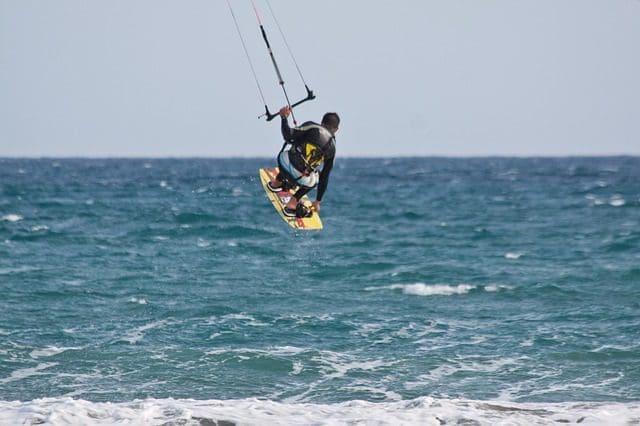
Each year there are more of them. Hardly a beach remains where sunbathers are not treated to the sight of an array of brilliantly colored kites out at sea. They belong to kite surfers, professionals and amateurs alike, practising their jumps and reaching outrageous heights while moving across the water with alarming speed.
Wakesurfing is a water sport in which a rider trails behind a boat, riding the boat’s wake without being directly pulled by the boat. Here’s a wakesurfing guide.
As the name suggests, kite surfers use a board similar to a wakeboard in size and shape, and a kite that acts as a sail, to pull them across the water. As the kite is maneuvered left and right, so a kite surfer is able to control his direction and, with time, move into the air to perform tricks and acrobatics.
A fusion of windsurfing, wakeboarding, and paragliding, kite surfing has been labeled the most extreme water sport. Invented by the French, and popularised by Robbi Naish in Hawaii, the pace of development of the sport over the past five years has been rapid. This and the degree of publicity this adventure sport attracts may account for its burgeoning popularity.

It has been described as less dangerous than skydiving but more so than windsurfing and more fun than both. Jonny Biggins, a British kite surfer living in Barcelona, admits that the danger factor is a huge pull. For him it is the most exciting and exhilarating sport there is. However, he also stressed that it needn’t be too dangerous for those who know what they are doing. There is a kite-surfing code of conduct, and the most important rule is to always watch the kite’s lines.
While part of the attraction is undeniably related to the danger factor involved, kite surfing is not a difficult sport. It can be learned in a week. Once you’ve learnt the basics, all it really takes is practise. While windsurfing can take years to master, within weeks kite surfers can jump and perform aerial tricks.
The basic principles involved are relatively easy to learn; jumping and landing after the jumps require more finesse. Most courses offer a simple eight-hour training program for beginners. Marc Argenso, an instructor at Escola Nautica Garbi, in Castelldefels, maintains that this training is needed to safely kite surf alone. Students master the necessary techniques after three hours on land, learning about the wind and how to control the kite and five on the water.
While most adventure sports demand strength and high fitness, kite surfing is less physical than aerobic and relies more heavily on technique than pure muscle. While in windsurfing, the sail can be cumbersome and requires a certain amount of strength to haul it out of the water, in kite surfing the wind does the work. The clothing also has to be proper for surfing. There are many surf clothing brands that you can choose from.
For this reason, Pedro Rius, the owner of the Front Fred shop in Barcelona and a kite surfer for six years, believes women have the potential to dominate the sport. He maintains that women are faster learners and more adept at concentrating on technique; whereas men tend to rely on sheer strength and are more intent on showing off or being macho.
In terms of location, the beach at Barceloneta is a viable option, though the wind can be gusty and there is an expanse of rock to avoid. Most kite surfers here flock to Castelldefels, as the beach is five thousand metres long and a hundred metres wide, providing lots of space in which to make mistakes. The beach at Bogatell is also popular, as it tends to be emptier than those in Barceloneta. Be careful to always check the wind; an offshore wind can drag a kite surfer out to sea.
Because of the crowded beaches, kite surfing is prohibited in Catalunya from June to September. Nevertheless, on specific fairly remote beaches, a few clandestine kite surfers can be seen throughout the summer. These folks can’t wait to fly their kites and don’t mind the occasional nudist. For the rest, the September skies beckon.
Useful information:
Equipment (including kite, board, harness, and lines):
New 1200 – 1400 euros, Second-hand 800 – 900 euros
(Second-hand equipment should be no more than two years old as the older the kite, the less durable it will be)
Kite Shops in Barcelona:
Front Fred, c/Diputacio 282; Tel 93318 45 81
Ventilador, c/Diputacio 212; Tel 93 323 56 24; www.ventilador.com
Courses:
Escola Nautica Garbi, www.escolagarbi.com; Tel 609 752 175
8 Hours 250 euros. Price includes use of all equipment, wetsuits and facilities.
Escola Front Fred; Castedelldefels; Tel 651 974 080; 629 718 616
8 Hours 220 euros
Useful Websites:
www.pkra.info, www.secretkiteboarding.com, www.kitesurfing.org

Be the first to comment